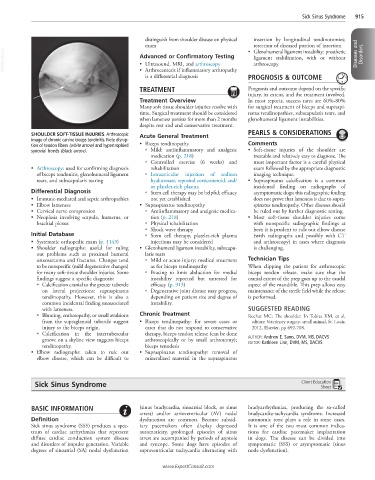Page 1828 - Cote clinical veterinary advisor dogs and cats 4th
P. 1828
Sick Sinus Syndrome 915
distinguish from shoulder disease on physical insertion by longitudinal tendinotomies;
resection of diseased portion of insertion
exam • Glenohumeral ligament instability: prosthetic
VetBooks.ir Advanced or Confirmatory Testing ligament stabilization, with or without Diseases and Disorders
• Ultrasound, MRI, and arthroscopy
arthroscopy
• Arthrocentesis if inflammatory arthropathy
is a differential diagnosis PROGNOSIS & OUTCOME
TREATMENT Prognosis and outcome depend on the specific
injury, its extent, and the treatment involved.
Treatment Overview In most reports, success rates are 60%-80%
Many soft tissue shoulder injuries resolve with for surgical treatment of biceps and supraspi-
time. Surgical treatment should be considered natus tendinopathies, subscapularis tears, and
when lameness persists for more than 2 months glenohumeral ligament instabilities.
despite rest and and conservative treatment.
SHOULDER SOFT-TISSUE INJURIES Arthroscopic Acute General Treatment PEARLS & CONSIDERATIONS
image of chronic canine biceps tendinitis. Note disrup-
tion of tendon fibers (white arrow) and hypertrophied • Biceps tendinopathy Comments
synovial fronds (black arrow). ○ Mild: antiinflammatory and analgesic • Soft-tissue injuries of the shoulder are
medication (p. 218) treatable and relatively easy to diagnose. The
○ Controlled exercise (6 weeks) and most important factor is a careful physical
• Arthroscopy: used for confirming diagnosis rehabilitation exam followed by the appropriate diagnostic
of biceps tendonitis, glenohumeral ligament ○ Intraarticular injection of sodium imaging technique.
tears, and subscapularis tearing hyaluronate, repositol corticosteroid, and/ • Supraspinatus calcification is a common
or platelet-rich plasma incidental finding on radiographs of
Differential Diagnosis ○ Stem cell therapy may be helpful; efficacy asymptomatic dogs; this radiographic finding
• Immune-mediated and septic arthropathies not yet established does not prove that lameness is due to supra-
• Elbow lameness • Supraspinatus tendinopathy spinatus tendinopathy. Other diseases should
• Cervical nerve compression ○ Antiinflammatory and analgesic medica- be ruled out by further diagnostic testing.
• Neoplasia involving scapula, humerus, or tion (p. 218) • Most soft-tissue shoulder injuries come
brachial plexus ○ Physical rehabilitation with nonspecific radiographic findings at
○ Shock wave therapy best; it is prudent to rule out elbow disease
Initial Database ○ Stem cell therapy, platelet-rich plasma (with radiographs and possibly with CT
• Systematic orthopedic exam (p. 1143) injections may be considered and arthroscopy) in cases where diagnosis
• Shoulder radiographs: useful for ruling • Glenohumeral ligament instability, subscapu- is challenging.
out problems such as proximal humeral laris tears
osteosarcoma and fractures. Changes tend ○ Mild or acute injury: medical treatment Technician Tips
to be nonspecific (mild degenerative changes) as for biceps tendinopathy When clipping the patient for arthroscopic
for many soft-tissue shoulder injuries. Some ○ Bracing to limit abduction for medial biceps tendon release, make sure that the
findings suggest a specific diagnosis: instability reported but untested for cranial extent of the prep goes up to the caudal
○ Calcification cranial to the greater tubercle efficacy (p. 913) aspect of the mandible. This prep allows easy
on lateral projections: supraspinatus ○ Degenerative joint disease may progress, maintenance of the sterile field while the release
tendinopathy. However, this is also a depending on patient size and degree of is performed.
common incidental finding unassociated instability.
with lameness. SUGGESTED READING
○ Blunting, enthesopathy, or small avulsions Chronic Treatment Rochat MC: The shoulder. In Tobias KM, et al,
from the supraglenoid tubercle suggest • Biceps tendinopathy: for severe cases or editors: Veterinary surgery: small animal, St. Louis,
injury to the biceps origin. cases that do not respond to conservative 2012, Elsevier, pp 692-708.
○ Calcification in the intertubercular therapy, biceps tendon release (can be done
groove on a skyline view suggests biceps arthroscopically or by small arthrotomy); AUTHOR: Andrew E. Sams, DVM, MS, DACVS
EDITOR: Kathleen Linn, DVM, MS, DACVS
tendinopathy. biceps tenodesis
• Elbow radiographs: taken to rule out • Supraspinatus tendinopathy: removal of
elbow disease, which can be difficult to mineralized material in the supraspinatus
Sick Sinus Syndrome Client Education
Sheet
BASIC INFORMATION (sinus bradycardia, sinoatrial block, or sinus bradyarrhythmias, producing the so-called
arrest) and/or atrioventricular (AV) nodal bradycardia-tachycardia syndrome. Increased
Definition dysfunction are common. Because subsid- autonomic tone plays a role in some cases.
Sick sinus syndrome (SSS) produces a spec- iary pacemakers often display depressed It is one of the two most common indica-
trum of cardiac arrhythmias that represent automaticity, prolonged episodes of sinus tions for cardiac pacemaker implantation
diffuse cardiac conduction system disease arrest are accompanied by periods of asystole in dogs. The disease can be divided into
and disorders of impulse generation. Variable and syncope. Some dogs have episodes of symptomatic (SSS) or asymptomatic (sinus
degrees of sinoatrial (SA) nodal dysfunction supraventricular tachycardia alternating with node dysfunction).
www.ExpertConsult.com

